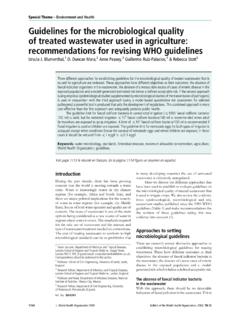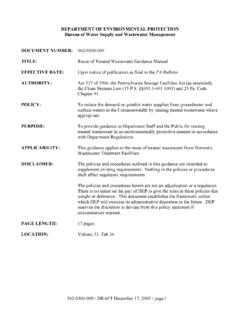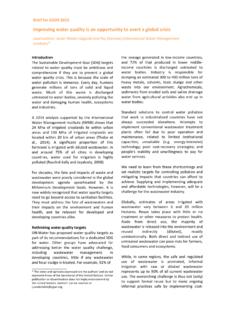Transcription of OPTIONS FOR SIMPLE ON-FARM WATER TREATMENT IN …
1 # 1 Third edition of the WHO Guidelines for the Safe Use of wastewater , Excreta and Greywater in agriculture and AquacultureGuidance note for National Programme Managers and EngineersOPTIONS FOR SIMPLE ON-FARM WATER TREATMENT IN dEvELOPINg cOuNTRIESINTRODUCTIONThe lack of wastewater TREATMENT capacity, which is especially prominent in low-income countries, has resulted in untreated wastewater polluting streams and rivers used for crop irrigation. This situation calls for further OPTIONS for health risk reduction.
2 Hence, while source TREATMENT of wastewater remains the priority option, implementing supplementary, or in the worst case alternative, non-conventional TREATMENT or non- TREATMENT measures appears, at least for the time being, crucial to reduce health risks posed by the use of untreated or only partially treated wastewater in agriculture . This Guidance note presents some point-of-use irrigation WATER TREATMENT OPTIONS , which are low-cost, often build on farmers own infrastructure and have shown potential in reducing microbiological crop contamination in smallholder farming ( ha) in developing countries.
3 The effectiveness of most systems varies with the area available and commitment of farmers to install and/or maintain them. While the area can not be changed, farmers commitment can be supported through incentives. farm -based TREATMENT is never a singular measure for risk reduction, but, depending on local conditions, it may be an important component of an incremental risk management strategy. Its value comes to expression in combination with other measures, such as safer irrigation practices and post-harvest food safety measures.
4 The reader should thus feel encouraged to use the cases presented here as examples for local adaptation and upgrading. They address ON-FARM ponds, filter systems and conventional irrigation Pond-based ON-FARM WATER TREATMENT systemsIn many countries smallholder-farmers in urban and peri-urban areas use ponds, dugouts, drums or concrete tanks for various reasons. Dugouts and ponds may collect surface flow or subsurface flow near streams (Figure 1), function as storage reservoirs for pumped drain or stream WATER , or simply reduce walking distances to WATER sources where watering cans are the means of irrigation (Figure 2).
5 Where the slope allows, farmers may link their ponds or reservoirs via narrow trenches in a network which can further reduce manual WATER transport (Figure 3). These types of informal irrigation infrastructure offer obvious opportunities for pathogen reduction through sedimentation, even at small scale. Pond systems are widely used as SIMPLE , low-cost but effective biological wastewater TREATMENT systems in many countries, not only in low-income countries. They remove helminth eggs and protozoa cysts mainly by sedimentation, while pathogenic bacteria and viruses are removed by a combination of factors that create an unfavorable environment for their survival.
6 As long as the required retention times can be maintained most of these processes also work in small ON-FARM 129/07/10 14:57:02# 2# 3To facilitate WATER collection, especially in smaller wastewater drains or streams, farmers block the WATER flow with sand bags or other materials, to create deeper pools suitable for watering cans. Often it is also possible to create cascades of small dams which offers further OPTIONS for sedimentation processes ( ). Table 1 shows different forms of pond-based systems commonly used in developing countries, with potential to contribute to point-of-use wastewater TREATMENT .
7 TABLE 1. Overview of informal pond-based WATER TREATMENT systems in smallholder agricultureOn- farm sedimentation ponds Chinese -3-tank systemIn-stream damsDescriptionAlready installed small ponds, dugouts, drums or tanks (2-10 m2 surface) used for interim wastewater storage. Usually, WATER is fetched from these reservoirs with watering cans while they are filled by small upgrade a one-pond system for an undisturbed retention time, three ponds are a preferred option: one pond is being filled by the farmer, one is settling and the settled WATER from the third is being used for irrigation.
8 The pond size should exceed the daily WATER needs. To ease WATER collection in wastewater drains and streams farmers block the WATER flow to create pools with sand bags or other materials. These constructions can form cascades suitable for trapping helminth eggs (see also Table 3).Area requirement and/or size of pondsVaries with crop WATER needs ( crop type and climate) and the size of the cropped farm areaVaries widely but usually between 1 and 3 m3In West Africa: Pond volumes vary in general between 2 and 10 m3.
9 See leftPathogen removalStudies in Ghana show that a two-day period of settling removed almost all helminth eggs from the WATER (reduced to less than 1 egg per litre) and about 2 log units for coliform bacteria. However, ponds are often used every day or every other day resulting in lower reductions, especially when their volume is one-day period of quiescent settling removes almost all helminth eggs and can achieve a 1 to 2 log unit reduction of other pathogens. The longer the WATER can rest the more than one barrier helminth egg sedimentation can be significant.
10 Fecal coliform reductions of 2 log units were found in Accra. If sand bags are perforated and closely packed, they can also function as sand into ponds or touching the bottom with the watering can will stir up settled pathogens (training needed).Having alternative ponds will increase retention time (see right).Avoiding runoff of manure or contaminated WATER /soil into to dig more ponds than usually useful to fill ponds from streams. See comments for ponds bags might be washed away in the rainy season. Two or more barrier systems are et al.

















